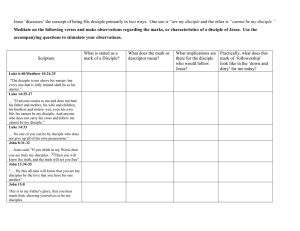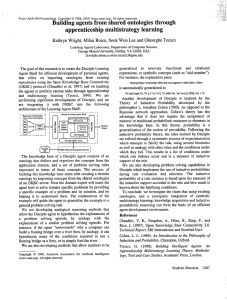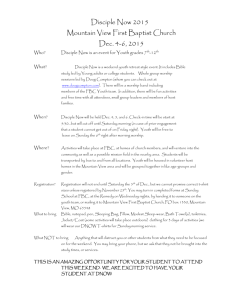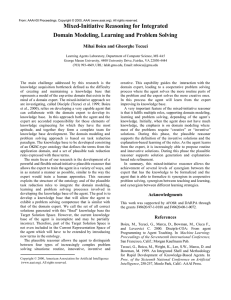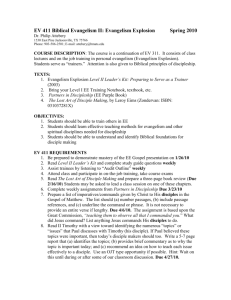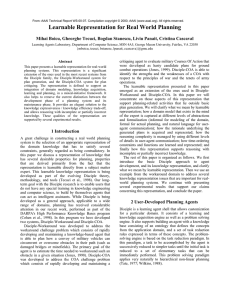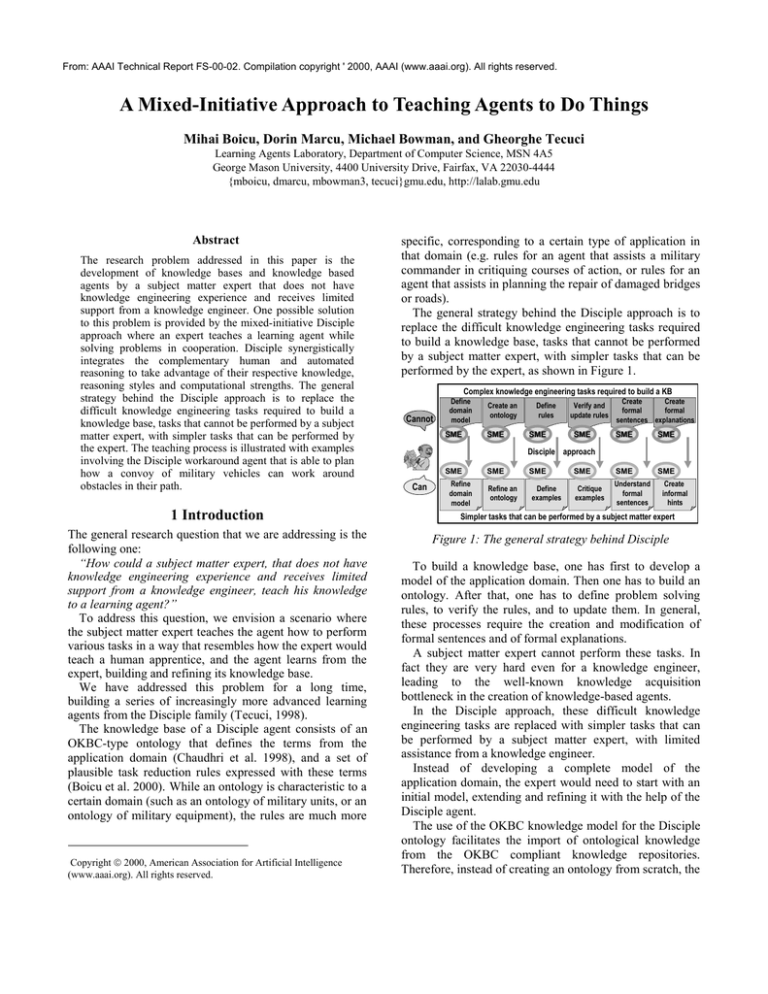
From: AAAI Technical Report FS-00-02. Compilation copyright ' 2000, AAAI (www.aaai.org). All rights reserved.
A Mixed-Initiative Approach to Teaching Agents to Do Things
Mihai Boicu, Dorin Marcu, Michael Bowman, and Gheorghe Tecuci
Learning Agents Laboratory, Department of Computer Science, MSN 4A5
George Mason University, 4400 University Drive, Fairfax, VA 22030-4444
{mboicu, dmarcu, mbowman3, tecuci}gmu.edu, http://lalab.gmu.edu
Abstract
The research problem addressed in this paper is the
development of knowledge bases and knowledge based
agents by a subject matter expert that does not have
knowledge engineering experience and receives limited
support from a knowledge engineer. One possible solution
to this problem is provided by the mixed-initiative Disciple
approach where an expert teaches a learning agent while
solving problems in cooperation. Disciple synergistically
integrates the complementary human and automated
reasoning to take advantage of their respective knowledge,
reasoning styles and computational strengths. The general
strategy behind the Disciple approach is to replace the
difficult knowledge engineering tasks required to build a
knowledge base, tasks that cannot be performed by a subject
matter expert, with simpler tasks that can be performed by
the expert. The teaching process is illustrated with examples
involving the Disciple workaround agent that is able to plan
how a convoy of military vehicles can work around
obstacles in their path.
1 Introduction
The general research question that we are addressing is the
following one:
“How could a subject matter expert, that does not have
knowledge engineering experience and receives limited
support from a knowledge engineer, teach his knowledge
to a learning agent?”
To address this question, we envision a scenario where
the subject matter expert teaches the agent how to perform
various tasks in a way that resembles how the expert would
teach a human apprentice, and the agent learns from the
expert, building and refining its knowledge base.
We have addressed this problem for a long time,
building a series of increasingly more advanced learning
agents from the Disciple family (Tecuci, 1998).
The knowledge base of a Disciple agent consists of an
OKBC-type ontology that defines the terms from the
application domain (Chaudhri et al. 1998), and a set of
plausible task reduction rules expressed with these terms
(Boicu et al. 2000). While an ontology is characteristic to a
certain domain (such as an ontology of military units, or an
ontology of military equipment), the rules are much more
.Copyright 2000, American Association for Artificial Intelligence
(www.aaai.org). All rights reserved.
specific, corresponding to a certain type of application in
that domain (e.g. rules for an agent that assists a military
commander in critiquing courses of action, or rules for an
agent that assists in planning the repair of damaged bridges
or roads).
The general strategy behind the Disciple approach is to
replace the difficult knowledge engineering tasks required
to build a knowledge base, tasks that cannot be performed
by a subject matter expert, with simpler tasks that can be
performed by the expert, as shown in Figure 1.
Complex knowledge engineering tasks required to build a KB
Cannot
Define
domain
model
SME
Create an
ontology
SME
Define
rules
SME
Verify and
update rules
SME
Create
Create
formal
formal
sentences explanations
SME
SME
SME
SME
SME
Critique
examples
Understand
formal
sentences
Disciple approach
SME
Can
Refine
domain
model
SME
Refine an
ontology
SME
Define
examples
Create
informal
hints
Simpler tasks that can be performed by a subject matter expert
Figure 1: The general strategy behind Disciple
To build a knowledge base, one has first to develop a
model of the application domain. Then one has to build an
ontology. After that, one has to define problem solving
rules, to verify the rules, and to update them. In general,
these processes require the creation and modification of
formal sentences and of formal explanations.
A subject matter expert cannot perform these tasks. In
fact they are very hard even for a knowledge engineer,
leading to the well-known knowledge acquisition
bottleneck in the creation of knowledge-based agents.
In the Disciple approach, these difficult knowledge
engineering tasks are replaced with simpler tasks that can
be performed by a subject matter expert, with limited
assistance from a knowledge engineer.
Instead of developing a complete model of the
application domain, the expert would need to start with an
initial model, extending and refining it with the help of the
Disciple agent.
The use of the OKBC knowledge model for the Disciple
ontology facilitates the import of ontological knowledge
from the OKBC compliant knowledge repositories.
Therefore, instead of creating an ontology from scratch, the
expert would only need to update and extend an imported
ontology (Boicu et al. 1999).
Instead of defining a complex problem solving rule, the
expert would only need to define a specific example of a
problem solving episode because Disciple will be able to
learn a rule from that example. This will be a partially
learned IF-THEN task reduction rule. Instead of a single
applicability condition, the rule will specify a plausible
space of hypotheses for its condition. This plausible
version space is represented by a plausible upper bound
condition and by a plausible lower bound condition (see
Figure 10 for an example of such a rule).
Instead of debugging a complex problem solving rule,
the expert would only need to critique specific examples of
problem solving episodes and Disciple will accordingly
update the corresponding rule.
Most of the time, the expert would not need to create
formal sentences or explanations, but only to understand or
modify such sentences/explanations that were generated by
Disciple, based on informal hints provided by the expert.
2. Mixed-Initiative Reasoning
The Disciple approach is based on several levels of
synergism between the expert that has the knowledge to be
formalized and the agent that has some knowledge on how
to formalize it. This multi-level synergism is achieved
through mixed-initiative reasoning that integrates
complementary human and automated reasoning to take
advantage of their respective knowledge, reasoning styles
and computational strengths. The mixed-initiative
reasoning is based on a division of responsibility between
the expert and the agent for those elements of knowledge
engineering for which they have the most aptitude, such
that together they form a complete team for the
development of the agent’s knowledge base. This requires
permanent coordination of the dialogue between the human
and the agent, and continuous shift of the initiative and
control.
At a higher level there is the synergism in solving
problems, where the agent contributes routine and
innovative solutions, the expert contributes creative
solutions, and they cooperate in defining inventive
solutions, as indicated in Figure 2.
Problem
Final
Representation
Space
Current
Representation
Space
Creative solution
Expert
Solution
Space
Final
Representation
Space
Current
Representation
Space
Target
Solution
Space
Correct creative
solutions
Correct inventive
solutions
Incorrect
inventive
solutions
Inventive solution
Correct innovative
solutions
Innovative solution
Correct routine
solutions
Incorrect
innovative
solutions
Incorrect
routine
solutions
Routine solution
Figure 2: Expert-agent problem solving synergism
The routine solutions are those that satisfy the plausible
lower bound conditions of the task reduction rules, and are
very likely to be correct. The innovative solutions are those
that satisfy the plausible upper bound conditions. These
solutions may or may not be correct and have to be
checked by the expert who can accept or reject them.
These situations will lead to a refinement of the involved
task reduction rules. The inventive solutions are based on
weaker forms of plausible reasoning (such as partial
matching of the plausible conditions of the rules, and tasks
similarity based on the structure of the ontology). An
inventive solution is based on an analysis of several rules,
and is generally a novel task reduction. From inventive
solutions the agent will learn new plausible task reduction
rules. Finally, the creative solutions are those that cannot
even be expressed in the current agent’s representation
language. These solutions have to be provided by expert.
They will lead both to an extension of the ontology, and to
the learning of new rules. As a result of this learning
process, the problem solving situations that were
innovative for the agent gradually become routine, and
those that were creative, gradually become inventive, then
innovative and ultimately routine.
At the next level down, there is the synergism between
teaching and learning, illustrated in Figure 3.
examples,
facts,
rules
Input knowledge
learning hints
Explicit learning guidance
Problem solving behavior
classification of examples,
problem solutions
Explicit teaching guidance
questions
Figure 3: Expert-agent teaching/learning synergism
Generally, the expert provides an input to the agent, in
the form of examples, facts, or abstract knowledge. The
agent learns concepts or rules from this input and applies
them to classify new examples or to solve some problems.
The expert analyzes this problem solving behavior of the
agent and provides feedback based on which the agent can
refine its knowledge. There is, however, another possible
feedback loop that could significantly enhance this mixedinitiative teaching and learning process. The expert can
help the agent to learn by providing useful hints, and the
agent can help the expert to teach it, by asking specific
questions.
Besides the synergism between the expert and the agent,
there is also the synergism between the different agent’s
components or employed methods. When the agent learns
from the expert, there is the synergism between different
learning strategies employed by the agent in situations in
which no single strategy learning method would be
sufficient. These methods include learning from examples,
learning from explanations, learning by analogy and
learning by experimentation (Tecuci 1998). Another
example of such synergism is that between domain
modeling, problem solving and learning that will be
discussed below.
A central component of the Disciple architecture is the
mixed-initiative manager that is capable to control the
transfer of initiative between different tasks performed by
the agent or by the expert, and to notify one another about
the relevant changes.
The tasks performed by the user and by the agent are
described in a formal language based on a taskdecomposition / task composition approach that provides a
useful similarity with the general problem solving
approach of Disciple. This framework allows the agent to
reason about the current tasks performed and to
dynamically adapt to the user’s actions.
The interactions between the expert and the agent are
complex and cannot be entirely predicted and specified
during development. The mixed-initiative manager may
guide the process toward the task completion by analyzing
and providing feedback related to the tasks performed, the
tasks currently executed, and the tasks that will need to
follow. The User-task Agenda, a key component of the
user–agent interaction manager, will exhibit all these
behaviors. It will display all the tasks relevant to the user at
different levels of abstraction, providing an increasing
efficiency of interaction as the human expert becomes
more experienced in collaborating with the agent. It will
also highlight the tasks that are currently being executed
and those that can be scheduled for execution at that time
to keep the expert informed with both the overall task and
the current status of the execution. Another capability of
the User-task Agenda is anticipating expert’s intentions by
generating all the possible tasks to be executed next,
selecting and displaying the ones that correspond most
closely to his actions, as a hierarchy reflecting their natural
order and inter-dependencies.
The mixed initiative manager also control the proactive
behavior of the agent that executes support tasks in
advance, in order to facilitate the initiation or completion
of an important task that will follow.
Domain modeling, problem solving and learning are the
main processes involved during the training of the Disciple
agent. The most difficult of them is the domain modeling,
which is the process of making explicit, at an abstract and
informal level, the way the expert solves problems.
Currently, domain modeling is manually done by a
knowledge engineer, being the most difficult barrier in
enabling a subject matter expert to directly teach an agent.
We are therefore investigating ways in which the agent can
assist the expert in the domain modeling process, partially
automating it. Besides relying on a mixed-initiative
approach, we are also researching the possible
relationships between domain modeling, problem solving
and learning, trying to find ways in which they could
support each other, as indicated in Figure 4.
creative or
inventive solution
knowledge for
inventive solution
Problem
Solving
example
Domain
Modeling
rule
abstract
example
Learning
abstract rule
Figure 4: Synergism between domain modeling,
problem solving and learning
There is a clear relationship between problem solving
and learning. Problem solving provides examples for
learning. Learning generalizes the examples to rules or
refines existing rules that are used in future problem
solving processes.
We are investigating the relationship between domain
modeling and problem solving. Both represent the same
reasoning process, but at different levels of abstraction and
formalization. The domain modeling will provide and
refine the models that will guide the cooperative problem
solving process. Also a specific problem-solving episode
may refine and develop its initial model. When the
problem solver cannot solve a problem, the expert needs to
provide a creative solution, by first defining an abstract
model of it, and then by refining it for the problem solver.
There are, however, situations where the necessary
solution is not entirely creative, but has some similarities
with routine or innovative solutions. In such a case the
problem solver can assist the expert in domain modeling
by suggesting elements of an inventive solution.
We also plan to investigate the relationship between
domain modeling and learning. The knowledge in domain
modeling is mostly informal and the agent has only a
partial understanding and formalization of it. Therefore the
learning algorithms must be adapted to learn general
domain modeling rules from these abstract and informal
domain modeling examples. These abstract rules may
guide and help the user in further domain modeling.
However, these domain modeling rules may also help in
learning the problem solving rules.
At the basis of this integration and mutual support of
domain modeling, problem solving and learning, should be
a learnable representation of knowledge that would
represent knowledge at various levels of abstraction and
formalization: abstract and formal for domain modeling,
formal for problem solving and learning, and natural for
expert-agent communication.
3. The workaround challenge problem
Over the years, the Disciple approach has been developed
and scaled-up continuously, more recently as part of the
1997-1999 High Performance Knowledge Bases (HPKB)
program supported by DARPA and AFOSR (Cohen et al.,
1998). The organizations participating in HPKB were
given the challenge of rapidly developing and updating
knowledge-based systems for solving specially designed
challenge problems. The aim was to test the claim that,
with the latest Artificial Intelligence technology, large
knowledge bases can be built and updated quickly and
efficiently.
One challenge problem for the first part of the HPKB
program was to build a knowledge-based workaround
agent that is able to plan how a convoy of military vehicles
can “work around” (i.e. circumvent or overcome) obstacles
in their path, such as damaged bridges or minefields
(Jones, 1998). The input to the agent includes two
elements: (1) a description of the damage (e.g. a bridge is
destroyed – see Figure 5), and of the terrain (e.g. the soil
type, the slopes of the river's banks, the river's speed, depth
and width), (2) a detailed description of the resources in
the area that could be used to repair the damage (e.g. a
description of the engineering assets of the military unit
that has to workaround the damage, as well as the
descriptions of other military units in the area that could
provide additional resources).
Site 103:cross-section
Damage 200: destroyed bridge
Near approach
(Right approach)
Site 108
Bridge/River
gap = 25 meters
Far approach
(Left approach)
Site 104
Left bank
Site 105
Right bank
Site 107
River bed
Site 106
Figure 5: An example of a damaged bridge
The output of the agent consists of the most likely repair
strategies, each described in terms of three elements: (1) a
reconstitution schedule, giving the transportation capacity
of the damaged link (bridge, road or tunnel), as a function
of time, including both a minimum time and an expected
time; (2) a partially ordered plan of engineering actions to
perform the repair, and the minimum as well as the
expected time that each of these actions require; and (3) a
set of required resources for the entire plan and for each
action. To solve this problem we have developed the
Disciple-Workaround learning agent (Tecuci et al., 1999).
4. The Disciple agent training process
We will briefly illustrate the process of teaching the
Disciple-Workaround agent. The expert starts with a
specific task (e.g. “Workaround obstacle by unit10” in
Figure 6). Then he asks a question related to this task, the
answer of which leads to the reduction of this task to a
simpler one (or, in other cases, to several simpler tasks).
This process continues until the top level task is reduced to
a partially ordered sequence of elementary tasks that
represent the plan to workaround the obstacle.
Workaround obstacle
by unit10
Task T1
Rule R1
What is the type of obstacle?
Tunnel
Bridge at site100.
Crater
Workaround bridge obstacle
at site100
by unit10
Task T2
Rule R2
What is the type of damage200, the damage to the bridge?
Mined and
damaged
bridge.
Damaged bridge but no mines.
Only mines
Workaround unmined damaged bridge
damage-200
at site100
by unit10
Task T3
What type of workaround strategy to attempt?
Rule R3
Ford the river.
Repair the bridge.
Ford damaged bridge
at site100
by unit10
Task T4
Figure 6: Sample task reduction tree
From each task example Disciple learns a general task
pattern. Also from each task reduction step Disciple learns
a general task reduction rule. Let us consider the taskreduction example from Figure 7. First Disciple learns
general tasks from the task examples in the task reduction,
as illustrated in Figure 8. Disciple learns both an internal
representation and a natural language pattern for the task.
Notice that the ranges of the task features are only partially
learned, being represented as plausible version spaces. For
instance, the set of possible values of ?O1 could be
{site107} or the set of instances of any subconcept of
GEOGRAPHICAL-REGION.
Prepare river banks
at site103
using bulldozer-unit201
to allow fording by unit10
What bank needs
to be prepared?
Both site107 and site105 need
to be reduced because their
slopes are too steep for unit10
Report that
bulldozer-unit201
has been obtained by unit10
Reduce the slope
of site107
by direct cut
using bulldozer-unit201
to allow the fording by unit10
Ford
bulldozer-unit201
at site103
Reduce the slope
of site105
by direct cut
using bulldozer-unit201
to allow the fording by unit10
Figure 7: An example of task reduction
Reduce the slope of site107, by direct cut, using
bulldozer-unit201, to allow the fording of unit10.
Task Examples
Reduce the slope of site105, by direct cut, using
bulldozer-unit201, to allow the fording of unit10.
Learned Task
REDUCE-THE-SLOPE
PUB:
GEOGRAPHICAL-REGION
PLB:
SITE107
?O1
OF
BY-DIRECT-CUT
PUB:
EQUIPMENT
PLB:
BULLDOZER-UNIT201
?O2
USING
PUB:
MODERN-MILITARY-ORGANIZATION
?O3
TO-ALLOW-FORDING-BY
PLB:
NL description
UNIT10
Reduce the slope of ?O1, by direct cut, using
?O2, to allow the fording of ?O3.
Figure 8: Learning a task description from examples
Disciple also learns a general task reduction rule from this
task reduction example. The process of learning the rule is
represented in Figure 9. Disciple tries first to understand
why the task reduction step is correct. It uses analogical
reasoning, natural language processing and hints from the
expert to propose plausible explanations from which the
expert selects the correct ones.
New task
reduction step
Rule
Generator
Explanations
Explanation Generator
Explanation
Editor
Hint
Assistant
new rule
NL
Processing
Analogy
Engine
KNOWLEDGE
BASE
Figure 9: The rule learning process
The explanations of the task reduction from Figure 7 are
the following ones:
1.
2.
3.
4.
5.
Unit10 located-at site108 and
Site103 right-approach site108 and
Site103 right-bank site107
Unit10 has a default-negotiable-slope of 25 and
Site107 has a max-slope of 200 > 25.
Site107 is on the opposite-side of site105.
Site105 is a bank.
Unit10 has a default-negotiable-slope of 25 and
Site105 has a max-slope of 200 > 25.
Based on the example from Figure 7 and on the above
explanations Disciple automatically generates the complex
task reduction rule from Figure 10
The Disciple-Workaround agent was developed very
rapidly, based on sample solutions provided by a subject
matter expert. During the 17 days of DARPA’s evaluation
of our agent, its knowledge base was increased with 147
concepts, 104 tasks and 206 task reduction rules. This
agent had the best correctness among all the teams that
participated in the workaround challenge problem, and was
selected to represent the HPKB program at EFX’98, the
Air Force’s show case of the most promising technologies.
One challenge problem for the second part of the HPKB
program was to build a critiquing agent that can evaluate
military Courses of Action (COA) that were developed as
hasty candidate plans for ground combat operations. To
solve this challenge problem we developed the DiscipleCOA learning agent, and in the process we achieved two
significant milestones with the Disciple approach. 1) For
the first time we developed the knowledge base around an
ontology created by another group (Teknowledge and
Cycorp), demonstrating both the feasibility of knowledge
reuse with the Disciple approach, and the generality of the
Disciple rule learning and refinement methods. Moreover,
the Disciple-COA agent was taught even more rapidly than
the Disciple-workaround agent, and has demonstrated a
higher performance than the other developed critiquers. 2)
For the first time we conducted a knowledge acquisition
experiment where four subject matter experts with no prior
knowledge engineering experience received very limited
training in the teaching of Disciple-COA and then each
succeeded to significantly extend its KB, receiving only
very limited support from a knowledge engineer (Tecuci et
al., 2000).
5. Conclusions
In this paper we have briefly presented the Disciple
approach, which represents a preliminary answer to the
research question addressed in this paper.
With respect to this approach to agent development we
formulate the following claims that have been tested during
the intensive evaluations of the DARPA’s HPKB program:
• it significantly speeds up the process of building and
updating a high performance knowledge base;
• it enables rapid learning of problem solving
knowledge from domain experts, with limited
assistance from knowledge engineers;
• the learned problem solving knowledge is of a good
enough quality to assure a high degree of correctness
of the solutions generated by the agent;
• the acquired problem solving knowledge assures a
high performance of the problem solver.
Our long-term vision is to develop a capability that will
allow typical computer users to build and maintain
knowledge bases and knowledge-based agents, as easily as
they use personal computers for text processing or
email.Therefore, this research aims at changing the way
future knowledge-based agents will be built, from being
programmed, to being taught.
If the task
to accomplish is:
Prepare river banks
at ?O1
using ?O2
to allow fording by ?O3
and the question
What bank needs to be prepared?
has the answer
Both ?O5 and ?O6 need to be reduced because their slopes are to steep for ?O3
?O3 located-at ?O4 and ?O1 right-approach ?O4 and ?O1 right-bank ?O5
?O3 has a default-negotiable-slope of ?N1 and ?O5 has a max-slope of ?N2 > ?N1
?O5 is on the opposite-side of ?O6 and ?O6 is a bank
?O3 has a default-negotiable-slope of ?N1 and ?O6 has a max-slope of ?N3 > ?N1
because
• ?O1 is site103
Plausible • ?O1 is site
right-approach ?O4
Upper
right-bank ?O5
Bound • ?O2 is military-equipment
Plausible
right-approach ?O4
Lower
right-bank ?O5
Bound • ?O2 is bulldozer-unit201
• ?O3 is military-unit
located-at ?O4
default-negotiable-slope ?N1
• ?O4 is approach
• ?O5 is geographical-bank
max-slope ?N2
opposite-site ?O6
• ?O6 is geographical-bank
max-slope ?N3
• ?N1 [ 0.0 , 200.0 ]
• ?N2 (0.0 , 1000.0 ]
> ?N1
• ?N3 (0.0 , 1000.0 ]
> ?N1
Plausible
Version
Space
Condition
then decompose
the task
into the subtasks
AFTER
?T1 Reduce the slope
Report that
of ?O5
?O2
by direct cut
has been obtained by ?O3
using ?O2
to allow the fording by ?O3
?T2
• ?O3 is unit10
located-at ?O4
default-negotiable-slope ?N1
• ?O4 is site108
• ?O5 is site107
max-slope ?N2
opposite-site ?O6
• ?O6 is site105
max-slope ?N3
• ?N1 { 25.0 }
• ?N2 { 200.0 }
> ?N1
• ?N3 { 200.0 }
> ?N1
Ford
AFTER ?T1
?O2
at ?O1
?T3
Reduce the slope
AFTER ?T2
of ?O6
by direct cut
using ?O2
to allow the fording by ?O3
Figure 10: Partially learned task reduction rule
Acknowledgments.
This research was done in the GMU Learning Agents
Laboratory (LALAB). Research of the LALAB is
sponsored by the Defense Advanced Research Projects
Agency (DARPA), the Air Force Office of Scientific
Research (AFOSR) and Air Force Research Laboratory,
Air Force Material Command, USAF, under agreement
number F30602-00-2-0546, grant number F49620-97-10188 and grant number F49620-00-1-0072. The U.S.
Government is authorized to reproduce and distribute
reprints for Governmental purposes notwithstanding any
copyright annotation thereon. The views and conclusions
contained herein are those of the authors and should not be
interpreted as necessarily representing the official policies
or endorsements, either expressed or implied, of DARPA,
AFOSR, the Air Force Research Laboratory, or the U.S.
Government. Cascaval, C., Ciucu, F., Hamburger, H.,
Jenkins, T., Levcovici, C., Shyr, P., and Stanescu, B., have
contributed to the current version of the Disciple approach.
References
Boicu, M., Tecuci, G., Bowman, M., Marcu, D., Lee, S. W. and
Wright, K. 1999. A Problem-Oriented Approach to Ontology
Development. In Proceedings of the AAAI Workshop on Ontology
Management, 7-16, Menlo Park, California: AAAI Press.
Boicu, M., Tecuci, G., Marcu, D., Bowman, M., Shyr, P., Ciucu,
F., and Levcovici, C. 2000. Disciple-COA: From Agent
Programming to Agent Teaching. In Proceedings of the
Seventeenth International Conference of Machine Learning, 7380, San Francisco, California: Morgan Kaufmann Publishers.
Cohen, P., Schrag, R., Jones, E., Pease, A., Lin, A., Starr, B.,
Gunning, D., and Burke, M. 1998. The DARPA HighPerformance Knowledge Bases Project. AI Magazine 19(4): 2549.
Chaudhri, V. K., Farquhar, A., Fikes, R., Park, P. D., and Rice, J.
P. 1998. OKBC: A Programmatic Foundation for Knowledge
Base Interoperability. In Proceedings of the Fifteenth National
Conference on Artificial Intelligence, 600–607, Menlo Park,
California: AAAI Press.
Jones, E., 1998. HPKB Workaround Challenge Problem
Specification, Alphatech, Inc., Burlington, MA.
Tecuci, G. 1998. Building Intelligent Agents: An Apprenticeship
Multistrategy Learning Theory, Methodology, Tool and Case
Studies. London, England: Academic Press.
Tecuci, G., Boicu, M., Wright, K., Lee, S. W., Marcu, D. and
Bowman, M. 1999. An Integrated Shell and Methodology for
Rapid Development of Knowledge-Based Agents. In Proceedings
of the Sixteenth National Conference on Artificial Intelligence,
250-257, Menlo Park, California: AAAI Press.
Tecuci G., Boicu M., Bowman M., Marcu D., Shyr P., and
Cascaval C. 2000 "An Experiment in Agent Teaching by Subject
Matter Experts," International Journal of Human-Computer
Studies, to appear.


